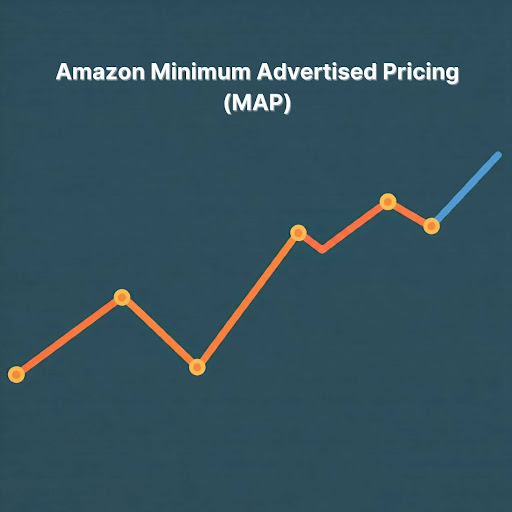How to Understand Amazon Minimum Advertised Pricing (MAP)

As an Amazon seller, you've likely heard of Minimum Advertised Pricing (MAP). While it might seem straightforward, there's more beneath the surface that can impact your business significantly.
In this comprehensive guide, we'll break down what MAP pricing is, how it functions on Amazon, and why it's crucial for your online selling strategy.
What Exactly Is MAP?
MAP stands for Minimum Advertised Price, which is the lowest price at which a product can be advertised—not necessarily sold. This price is set by the manufacturer and is federally mandated to maintain brand value and fair competition among resellers.
MAP vs. Selling Price
It's important to note that MAP refers to advertised prices. Sellers can still sell a product below the MAP as long as they don't advertise it at that lower price. Understanding this distinction is vital for staying compliant with manufacturer agreements and avoiding penalties.
How Does MAP Function?
To grasp how MAP works, consider this example:
Imagine a company sets the MAP for its best-selling hairdryer at $32. As a reseller, you're required to advertise this hairdryer at no less than $32. If you decide to advertise it for $25 in a promotion, you'd be violating the MAP agreement.
Calculating MAP from MSRP
Typically, MAP is calculated by reducing the Manufacturer Suggested Retail Price (MSRP) by a certain percentage, often around 20%. For instance:
-
MSRP: $40
-
MAP: $40 - (20% of $40) = $32
Understanding this calculation helps you stay within the acceptable advertising price range.
Why Is MAP Important for Amazon Sellers?
Adhering to Amazon MAP pricing policies is crucial because:
-
Price Comparison: Up to 92% of online shoppers compare prices before making a purchase.
-
Brand Integrity: Consistent pricing maintains the perceived value of products.
-
Fair Competition: MAP policies level the playing field among sellers of all sizes.
Failing to comply with MAP agreements can lead to negative consequences for your business, including damaged relationships with distributors and diminished product value.
Benefits of MAP for Distributors
1. Limiting Undercutting by Unauthorized Sellers
MAP policies prevent unauthorized sellers from advertising excessively low prices to divert sales unfairly.
2. Preventing Price Erosion
Consistent pricing avoids the downward spiral of price competition, which can erode profit margins and brand value.
3. Strengthening Distributor Relationships
Compliance with MAP demonstrates reliability, fostering stronger, long-term partnerships with manufacturers.
4. Level Playing Field
Both small and large businesses can compete fairly without the threat of being undercut by larger competitors with more pricing flexibility.
5. Maintaining Product Value
Consistent advertised pricing preserves the perceived value of products in the eyes of consumers.
Consequences of Violating MAP Policies
-
Loss of Product Value: Repeated violations can decrease what customers are willing to pay.
-
Damaged Reputation: Distributors may lose trust, limiting your access to products.
-
Terminated Partnerships: Manufacturers may cease doing business with you, impacting your inventory and sales.
How Distributors Can Optimize MAP Policies
1. Implement Product Serial Numbers
Tracking serial numbers helps identify and address MAP violators effectively.
2. Monitor Sellers Proactively
Use monitoring tools to ensure sellers comply with MAP agreements and encourage open communication.
3. Develop a Customized MAP Policy
Tailor your MAP policy to your company's specific needs and have it reviewed by legal experts.
4. Ensure Clarity in Your MAP Policy
Avoid jargon and make the policy easily understandable to encourage compliance.
5. Treat All Resellers Equally
Apply your MAP policy consistently to all sellers, regardless of size.
6. Enforce MAP Policy Diligently
Since Amazon doesn't enforce MAP policies, it's up to you to monitor and address violations, possibly using specialized software for assistance.
Conclusion
Understanding and adhering to Amazon Minimum Advertised Pricing (MAP) is essential for maintaining healthy distributor relationships, preserving product value, and ensuring fair competition. By following MAP guidelines, you protect your business and contribute to a stable marketplace.
If you need personalized guidance or help fine-tuning your strategies, Superfuel AI can assist. Our AI-powered assistant analyzes 36+ key Amazon metrics to identify and address the root causes of sales fluctuations, helping you optimize your storefront and boost sales. Reach out to us at [email protected].
--
Ben Mathew, Amazon Expert
Ben Mathew is a co-founder at Superfuel, a sales assistant for Amazon sellers. In the past, Ben and his team of e-commerce specialists and software engineers have launched 40+ new brands on Amazon, taking them from zero to bestsellers. In his free time, he is either learning from other top sellers or encouraging his 3 daughters in their love for reading. He is reachable at ben [at] superfuel.io.
FAQs
What is the difference between MAP and MSRP?
-
MAP is the lowest price a product can be advertised for, set by the manufacturer.
-
MSRP is the manufacturer's suggested retail price, often higher than MAP.
Can I sell below MAP on Amazon?
Yes, you can sell below the MAP as long as you don't advertise the product at that lower price.
How does MAP benefit small businesses?
MAP policies level the playing field by preventing larger companies from undercutting smaller sellers through lower advertised prices.
What happens if I violate MAP policies?
Violations can lead to damaged relationships with distributors, loss of access to products, and a decrease in your product's perceived value.
Does Amazon enforce MAP policies?
No, Amazon does not enforce MAP policies. It's the manufacturer's responsibility to monitor and enforce compliance.